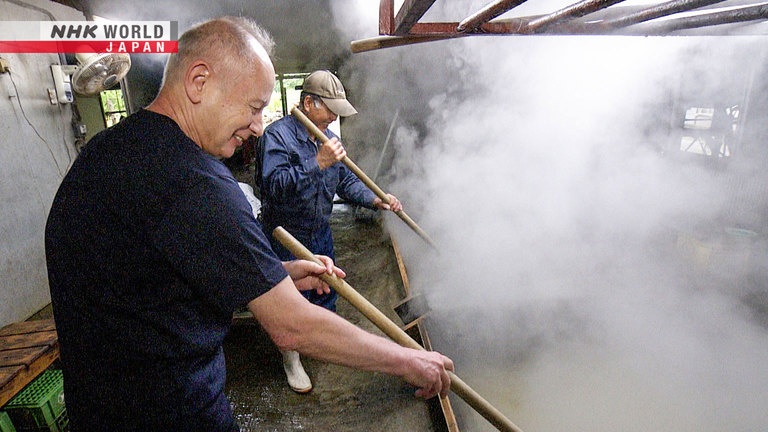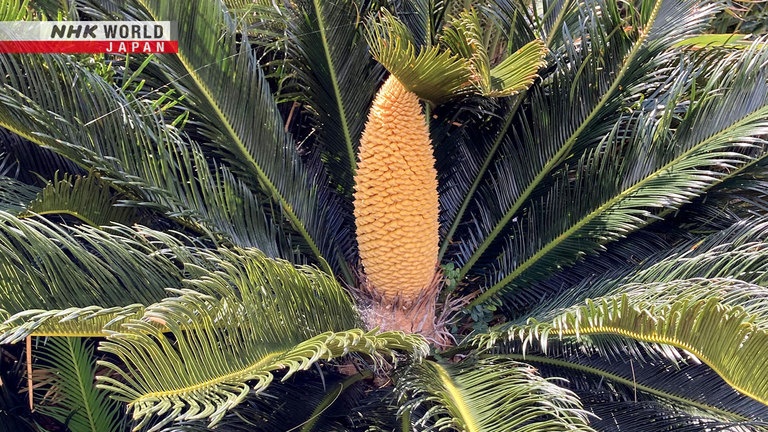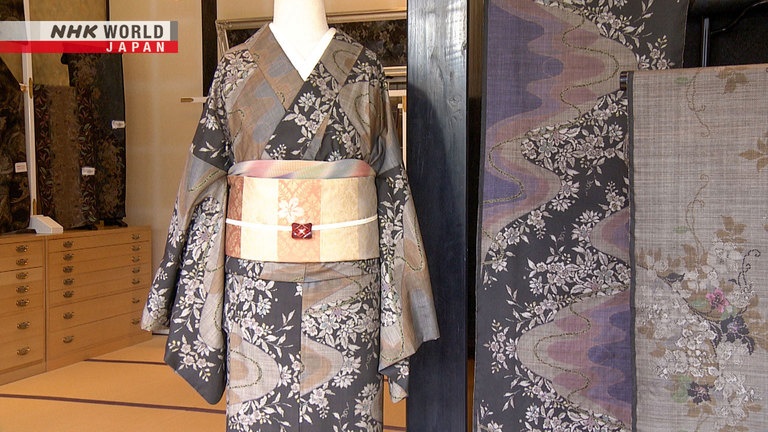Amami Oshima: Shaped by Adversity
*First broadcast on July 13, 2023.
Life in Amami Oshima was once so tough that the islanders devised a way to make a poisonous plant edible. Harsh circumstances nurtured their resilience and resourcefulness on a subtropical island that was ruled by different outside forces as the centuries passed. Folk music became a medium for private communication, and in secret they produced silk fabric with a distinctive black beauty. In the second of two episodes, Peter Barakan gets to the heart of Amami Oshima's unique culture.



Transcript
Hello, and welcome to Japanology Plus.
I'm Peter Barakan.
This is the second of two programs
about Amami Oshima.
Today we'll see how its unusual history
has given the island a unique character.
Amami was independent
for thousands of years,
until, in the latter part
of the 15th century,
it came under the control
of the Ryukyu Kingdom of Okinawa.
Later, it was part of the Satsuma Domain,
a powerful feudal clan of southern Japan.
Fast forward to the 20th century,
and at the end of the Second World War,
it was occupied by the American forces—
but just for eight years,
until it reverted to Japan in 1953.
Today, we'll see how each
of those outside influences
has left its mark on the culture
of contemporary Amami.
Amami Oshima is around
1,200 kilometers southwest of Tokyo.
Much of it is covered in forest,
which is full of rare plants and animals.
In 2021,
Amami Oshima was among a selection
of islands in this region
inscribed as a World
Natural Heritage site.
For centuries, the island
was an important trading hub.
Its population now is just over 55,000.
Warm ocean currents contribute
to high rainfall,
and that makes for productive farming,
even in winter months.
Amami Oshima is situated
between Kagoshima and Okinawa.
At different times in history,
it has been administered by both,
and each left a cultural legacy.
In the 15th century,
the Ryukyu Kingdom—
based in what is now Okinawa—
brought the island under its control.
That cultural influence is visible
in rituals that are practiced even today.
Then in the 17th century,
Amami Oshima was conquered
by the Satsuma Domain,
based on the mainland in
what is now Kagoshima.
The islanders had to please new masters.
Good morning.
Hello there!
Good to see you.
Our guest is Machi Kenjiro,
a folklore researcher
who speaks about Amami's traditional
appeal at schools and in lectures.
The Satsuma Domain invaded
in the 17th century
and maintained administrative control
for 260 years.
That was because, first and foremost,
Amami Oshima was in an important location.
And it also had
a really valuable resource.
OK. And that was...
I'll show you.
OK.
Here it is.
Do you know what it is?
Sugarcane.
These are really quite big.
The Satsuma Domain forced the islanders
to greatly boost production of cane sugar.
Eventually they even
collected it as a tax.
It was a valuable crop,
and Satsuma ordered
its cultivation all over the island.
Even today, sugarcane is grown on roughly
half of Amami Oshima's farmland.
Hello.
Oh, it spits out the juice.
What time do you start work?
Around 3:30 in the morning,
that's when we start extracting the juice.
The sugarcane itself
is harvested the day before.
The juice oxidizes very quickly,
and that ruins it,
so we have to work fast.
Each day, we squeeze out only enough for
that one day's worth of sugar production.
OK.
Around a tonne of sugarcane is squeezed
each day, over the course of four hours.
The cane juice is 80 percent water.
The moisture steadily evaporates, leaving
the other 20 percent—that's the sugar.
And fuel oil.
For good results,
it must be burning fiercely.
OK.
The juice from one tonne of sugarcane
is boiled in four batches.
Lime is added to help solidify the sugar.
In the past, crushed coral was used
for that purpose.
OK, it's started boiling now.
We're going to remove impurities
with a net.
Do you have to watch it all the time
while it's evaporating?
A layer of sugar forms at the top,
so we stir it to accelerate evaporation.
OK.
Want to try?
OK.
We're already starting to get
that distinctive brown sugar smell.
The color changes depending on the field
where the cane was grown.
— Oh really?
— Yes. The flavor, too.
Interesting.
One hour later...
A lot of resistance now.
It's getting quite kind of sludgy.
You can feel it starting to harden up
on the bottom.
Finally, the sugar is stirred in a machine
This improves its texture.
Feels like kind of caramel.
Yes, you're right.
Let's try it.
Hot.
It's so fresh.
There's a sweetness to it,
but it's got a real rich taste to it.
I don't think I've ever had sugar quite
like this before.
Islanders eat it when drinking green tea.
It's a fantastic combination.
They go very well together.
Really?
It's a combination I wouldn't have
thought of, but maybe we should try it.
So they go through this whole
process four times within a morning.
It's pretty hard work, isn't it?
And they've been doing it this way
for several hundreds of years now.
As we've seen,
sugar is challenging to make.
But it's also tough to transport.
The island doesn't have
very much flat land.
People would produce sugar
in simple huts on hillsides.
Then they'd pack it in barrels,
and take it down to the harbor.
It was a great deal of work
from start to finish.
The Satsuma Domain's demands
resulted in sugar being almost
unavailable to use in the place
where it was actually being made.
Was there enough left for them
to eat themselves?
Well, they disguised sugar as medicine.
That's the story at least.
They had to hide it?
Yes.
But hiding and selling the sugar
was a crime punishable by death.
That was the Satsuma law.
Really strict.
Yes, Satsuma rule was really demanding.
If a household was unable to pay the tax,
they had to borrow sugar to do so.
And for as long
as the debt remained unpaid,
they were forced to work in slavery.
So it's like cotton
in the US during the slavery years?
The circumstances were similar.
Some historians refer to it
as “sugar hell.”
Wow. I mean, sugar
which is sweet and enjoyable,
adds a little pleasure to your life,
became a hell to them.
That's pretty serious stuff.
To get as much sugar as possible,
the Satsuma Domain replaced other crops—
including sweet potatoes,
an important source of nutrition.
The islanders were desperate for something
they could eat as a staple,
and eventually they came up
with their own solution.
This landscape doesn't look special,
but it features something
that helped people to feed themselves.
Oh, the whole side
of the mountain's kind of brown looking.
Right. It doesn't look the same
as other mountains.
Are those palm trees?
Actually, they're called “sago palm.”
OK.
Sago provided the islanders
with a source of starch, all year round.
And that was crucial. It kept them alive.
The sago palm is an evergreen plant
that can grow even where the soil is poor.
The islanders cultivated it in areas
where sugarcane wouldn't have grown.
Its red fruit helped them
to avoid starvation.
Sago is no longer a common food, but
this restaurant keeps its memory alive.
Oh, OK. Thank you.
It's a bowl of sago palm soup.
It's quite starchy, yeah.
It tastes OK. I mean, it doesn't
really taste of anything very much.
Unprocessed, sago palm fruit is poisonous.
It cannot be eaten raw.
It must be sun dried,
then fermented in water, and rinsed.
The whole process takes three weeks.
That reflects the determination
and the resourcefulness of the islanders
in the face of severe hardship.
The restaurant's owner is Wada Akiho.
How was it?
It was good. It was the first time
I've ever had anything like this.
I've never tasted better.
I'm glad!
A food shortage struck again
in the Second World War.
Wada says that sago palm saved his life.
During the war, boats stopped coming.
Because of that, we didn't have much rice,
so we had to eat sago palm fruit instead.
This has always been,
I suppose, a subsistence food.
It's slightly surprising that you
would operate a restaurant serving this,
even now when people can eat
pretty much what they want to.
Well...
there is a history.
It's part of our culture.
And I want to pass it on.
As best I can.
So you want people to remember
history through serving this?
Yes. Preserving history,
and our culture...
that's my reason for serving this food.
We teach children about local history.
But when we tell them
that the islanders used to eat sago palm,
they can't imagine what it tasted like.
Here, they can try it for themselves.
It's really valuable.
Now for an element of island culture
with a great international reputation.
Oshima Tsumugi.
Silk threads are dyed a rich black,
and painstakingly woven.
Amami Oshima is the main base
for this unique local craft.
Garments made from it have been referred
to as wearable works of art.
Making the fabric requires
both great skill and hard work.
Here, you can see
all the different processes that
go into making Oshima Tsumugi.
That's great.
It's really famous.
I'm looking forward to seeing
how it's made.
- Hello.
- Hello.
Welcome.
This is a dye workshop.
At the very beginning,
we make use of a kind of tree.
Its scientific name
is Rhaphiolepis umbellata.
Here it is.
Oh.
This is the one.
We use the trunk and branches to make dye.
The wood is cut into small pieces,
and boiled for around 15 hours.
The result is a tannin-rich liquid.
Silk threads are soaked
in it and then dried.
Repeat this process around 20 times,
and the silk starts to turn brown.
The next step involves mud.
We soak it in muddy water.
The mud in the fields around here
is rich in iron.
The iron and the tannin
undergo a chemical reaction.
And that is what turns the silk black.
OK.
But only after four rounds
of that entire process.
At one time in history,
silk clothing was banned,
and islanders hid silk garments
in the muddy water of rice fields—
that's when they discovered
that the mud turned the fabric black.
This space is used only for dyeing.
You need to maintain a rhythm.
I dip each section around 12 times,
then I grab another section.
After three rounds of dipping,
the silk threads will be evenly coated.
Dipping the silk section by section
ensures that it is properly dyed.
Want to try it?
In this rain?
Alright, why not?
The mud's really sticky.
Yeah.
It's lovely mud though. It really is soft.
Anything rough would damage the silk.
But the mud that we use is very smooth.
1, 2, 3, 4, 5, 6, 7, 8.
It's like a metronome.
I understand that one.
1, 2, 3, 4...
I didn't get the rhythm like you though.
It takes years.
How many years have you been doing it?
34.
Ah, OK.
How long do you spend doing this,
well, this part of the process, every day?
Well, what we're dyeing here is a bundle.
One bundle.
I do 200.
And that takes me around three hours.
200 of these in three hours?
Even under the scorching summer sun. Yes.
And although winters aren't bad here,
the mornings can be cold.
With the water just six
or seven degrees Celsius.
It makes my hands go numb.
It's hard work.
After the dyeing process is complete,
the silk has a glossy black luster.
Weaving the thread is complicated too.
It involves using many different strands
that are custom dyed
in order
to accurately reproduce a pattern.
Up to 20 steps are required altogether.
It may take one year
to complete a specific item.
You can see a pattern
in the vertical lines, the warp threads.
My job is to weave
in matching horizontal weft threads.
If I lay this thread down, you can see
that the pattern matches perfectly.
Let me show you.
This is where we start.
In goes the thread.
And then you line it up.
When it rains, a thread may stretch.
So I take care that doesn't happen.
I must make sure the pattern looks good.
The main point is that the entire pattern
is already present in the thread.
The target each day is 30 centimeters.
The size of a handkerchief.
So it does take a long time!
Hello!
Hello.
So this is where
we see the finished article.
The pattern that you saw on the loom
just now is this one.
It's interesting because if we hadn't seen
how complex the process
for making them was...
if you saw them here,
the colors are generally fairly...
I mean they're simple colors,
mainly black and white.
But they don't jump out at you,
so you wouldn't realize
how much work has gone into them,
until you actually see it being done.
That's right.
You need to see the process for yourself
in order to understand
how much time it takes.
Each thread bears part of the design,
so there is no front or back.
Either side can be thought
of as the front.
A reversible fabric adds
to the life of a kimono.
It more easily
becomes a treasured family heirloom.
Ah, interesting.
This one here has a traditional design.
It's based on Amami's native plants.
It features the flower
of a sago palm, viewed from above.
These jagged lines are the leaves.
At the center is the flower.
The fruit is shown too.
It's amazing how something
as intricate as this is...
was made from hundreds and hundreds
of years ago, in a fairly remote island.
We're not talking about Kyoto,
for example.
The ingenuity that goes into the designs,
and the making of the thread,
and every step along the way,
is absolutely staggering.
They're beautiful geometric patterns.
Mountain paths, plants, rivers...
they took simple motifs from nature,
and used them to make a design.
When the islanders were coming up
with these patterns,
they took inspiration
from the island itself.
I think that's wonderful.
The folk music of Amami Oshima
is called “shimauta.”
For centuries, islanders used these songs—
sung in a local dialect—
to share the joys and struggles
of daily life,
and to come together as a community.
Each settlement has its own song, which
is still performed at regional gatherings.
We're going to visit a shop
that promotes this form of folk music.
The owner is Ibusuki Masaki.
Nice to meet you.
So...
These are sanshin.
The bodies are made of snakeskin?
Well, they used to be made of python skin,
but you can't get it any more.
So the new ones are artificial.
Ah...oh, so it looks like snakeskin,
but it's actually artificial? I see.
The shop has a display dedicated
to shimauta.
These are all Amami singers?
That's right.
OK. Are these all made by local labels?
We make them.
Oh! You have your own record company?
My dad started it.
Ibusuki's father started
releasing shimauta records in 1955.
He was already worried
about the music's future.
Right after the Second World War,
school leavers would go
to Osaka or Tokyo to work.
But they didn't speak standard Japanese.
Just Amami dialect.
In the big cities,
no one understood what they were saying.
And people would make fun of them.
Because of that, school teachers started
to crack down on the local dialect.
Kids weren't supposed to use it.
But shimauta songs were all sung
in local dialect.
The island music started to decline.
And die out.
Amami was presumably, at one point,
in danger of losing its cultural identity?
It was.
Ibusuki took over his father's project.
He began organizing events,
and enthusiastically promoting shimauta.
Several singers went on
to release music on major labels.
Amami has rediscovered its love
for this homegrown music,
which is once again putting down roots.
Ibusuki believes that,
throughout the island's long history,
shimauta has given people
the emotional strength to keep going.
Shimauta makes use of a vocal flip.
Going falsetto helps the voice
to carry a long way.
When the islanders were
under Satsuma's thumb,
the local dialect might have been useful
for private communication.
It's said people spoke it, or sang it,
so as not to be understood
by the Satsuma authorities.
They might use it to
insult those harsh rulers.
Or maybe to sing a warning.
“Watch out!”, —like this:
A local code.
The falsetto is a vestige of that history,
so people say.
Oppressed people tend to have intense,
vivid musical cultures, I think.
So I can understand that people
would have those kind of ideas.
Amami Oshima has layers
of Ryukyu culture, and Satsuma culture.
They overlap, forming something new.
That combination only happened here.
It's unique.
If you look at the history
of Amami Oshima,
the people here have had
to go through some pretty tough times.
But then people are basically,
I think, strong.
And out of adversity, often,
I think you get a very vibrant culture.
Plus they have this
wonderful subtropical natural climate,
which can help people
get through a lot of things, I think.
And if you look at the island now,
the culture is really unique.
And it's probably one
of the most
interesting cultures
within Japan, I think.
Thank you.